Everyday life
With the occupation, a new and demanding everyday life began...
How big impact the occupation had on people’s everyday lives depended on where they lived and their situation. Very many, and especially those who lived in urban areas, were struck by the extensive lack of goods. There was a shortage of food, clothes and equipment, and meeting the most basic needs in the household demanded great efforts in the form of hard work, time and creativity. Often the housewives contributed the most.
Many people experienced a basic feeling of insecurity – controls from the authorities and the presence of an occupation force were a daily burden. The bomb threat was real in many areas, and shelters and black-out curtains became a part of everyday life. In addition, there were a number of regulations and commands that limited people’s freedom of action and movement.
Photo from PA-1209 NTBs krigsarkiv, Ue, L101, Lines (the photo shows a food line at the crack of dawn on a rainy morning outside an outlet in Oslo).
Five years constitue a big part of a childhood, and the years of the occupation have influenced the generation who lived important, shaping childhood years 1940-45. Several archives can tell us something about childhood during the war.
School meals and the serving of soup
Many children had a poor diet, and many children were also struck by war in a way that made them in need of care. During the war and straight after, several efforts were made to ensure good nutrition through school breakfasts and soup serving, and to help the children that suffered the most from the war, through contributions, sponsorships and stays at health resorts. Central in this work was “Nasjonalhjelpen til de skadelidte distrikter/frihetskampens ofre” (a national institution that raised money and gave help to the victims of war). In this institution’s archive you will find a lot about children’s nutrition, rehabilitation in Sweden for sick children, correspondence and information about the sponsorship schemes, information about help-needing single children organized alphabetically, and an overview of the situation for the children of sailors.
The Norwegian Women’s Health Association and the Norwegian Red Cross were also active in the work to improve the lives of children. These organizations’ archives are preserved at the National Archives in Oslo, and you will find various information about children’s situation by searching the individual archives’ catalogues. The soup stations of “Danskehjelpen” (Danish humanitarian aid to Norway during World War II) were other important suppliers of food to Norwegian children during the war. In the archives there are accounts, lists of school classes and kindergartens, as well as letters and drawings from Norwegian children.
The legation in Bern’s archive contains a report regarding the situation in Norway with several photos of catering for children, the handing out of food, and drawings and thank-you notes from children in Norway. In the Norwegian Relief-Central in Sweden’s archive, especially in box 40 and 41, you will find information about aid to children in Norway.
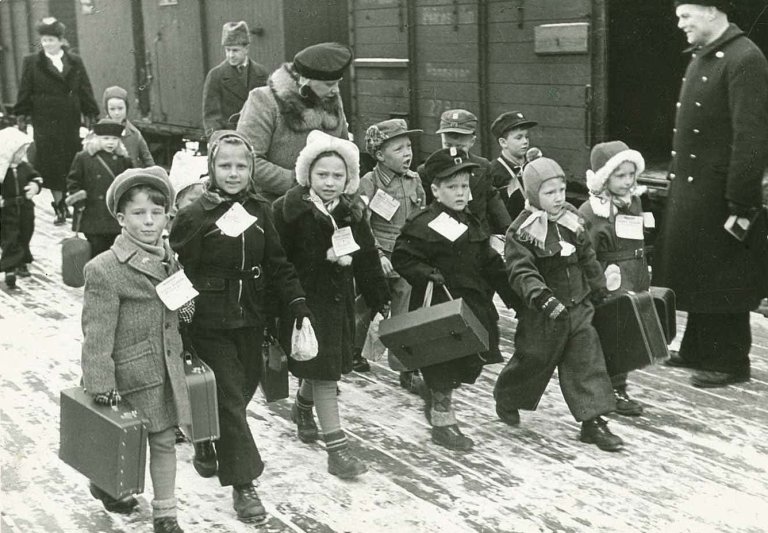
The children’s own experiences of war
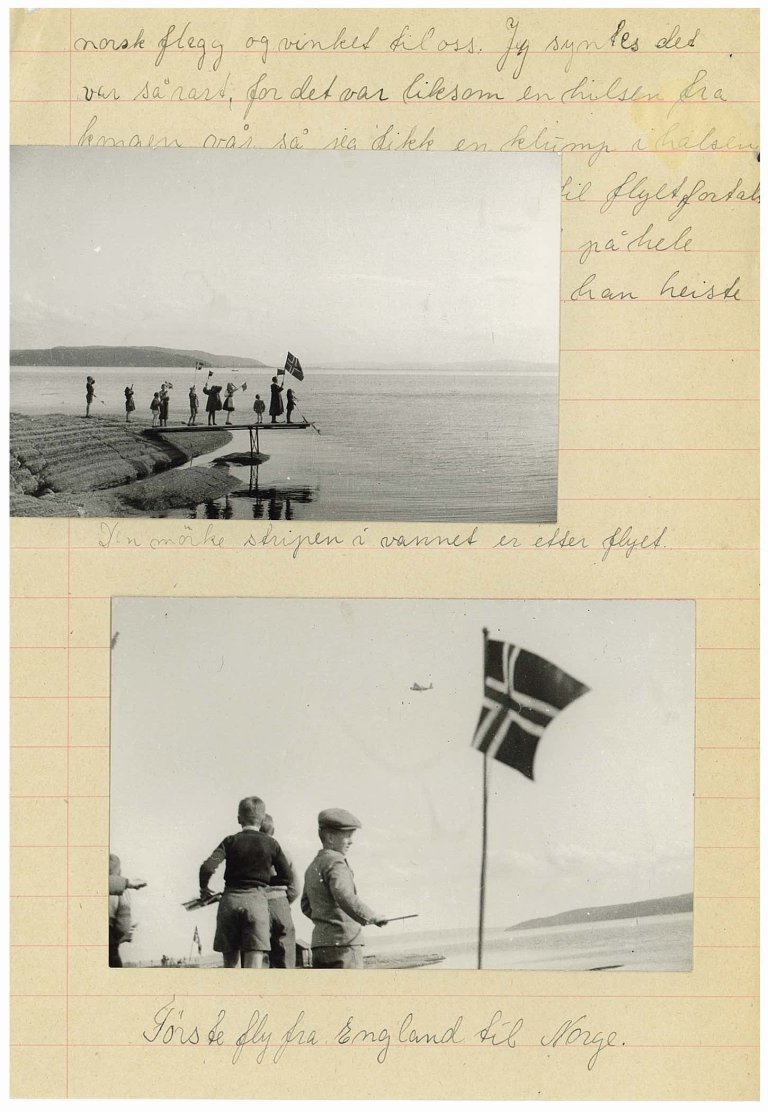
In the fall of 1946, an essay competition was organized for mainly 7th grade students with the topics ”A memory from the war” and ”When peace came”. The initiative came from The Norwegian Total Abstainers’ Society, and the essays are found in their archive. They give us a good opportunity to take part in the children’s own descriptions and interpretations of experiences from the war years and the peace day. Many of these essays describe dramatic memories that have made strong impressions. Bomb attacks and panicky stays in bomb-shelters, airplanes that have been shot down and encounters with traumatized prisoners of war, are among the themes. Some tell about the anxiety they felt when someone close to them were involved in illegal work, the fear of house searches and experiencing their father being arrested. Despite the fact that the events described often are dramatic, we also get insight into the elements of children's everyday lives, their everyday chores, and their food and housing situation. The children who chose the theme ”When peace came” not only tell about the overwhelming feeling of peace and freedom, but also about the everyday life in war that they left behind in May 1945.
Arkivportalen
- PA-0250 Norges Røde Kors/Fce Barnehjelp
- PA-1007 Nasjonalhjelpen til de skadelidte distrikter/frihetskampens ofre
- PA-0379 Norske Kvinners Sanitetsforening (organizing of food and clothes for children, including in corporation with Svenske Norgeshjelpen (the Swedish help to Norway))
- PA-0394 Danskehjelpens suppestasjoner
- S-2073 Den norske Relief-Central i Sverige. About help for children, especially box 40 and 41
- PA-0419 Det norske totalavholdsselskap/Eb/L0603
- S-2674 Utenriksstasjonene, Legasjonen i Bern, Sveits/D/59
The war was a dark time in a double sense. Black-out curtains made sure that cities and other strategically interesting bomb targets were kept dark. Black-out curtains were mandatory and those who didn’t follow order were fined, they could risk having their electricity cut and in some cases even harder sanctions came into question.
Dark streets
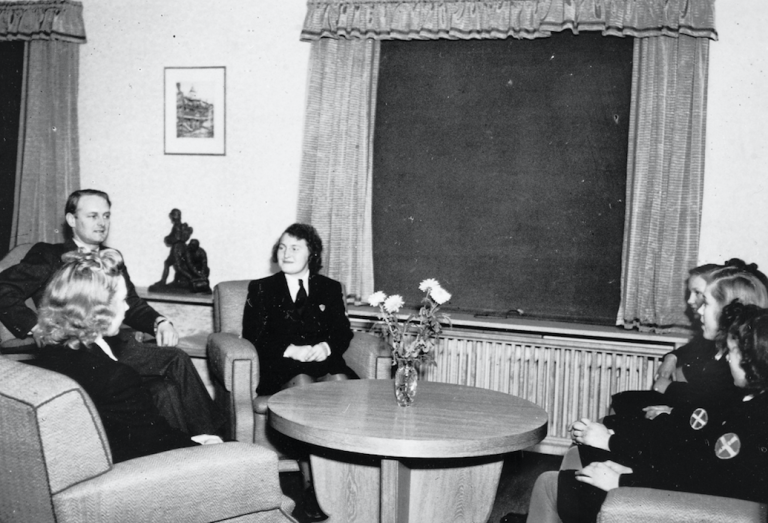
The purpose of the black-out was to make it difficult for airplanes to orientate, so that bomb targets, houses and the population were protected. The responsibility for black-out regulations and follow-ups was under The Office for Civil Air Defense in the Department of Justice. In this archive you will find numerous issues and correspondence related to black-out: regulations and the processes leading up to these, analysis, an overview over time for black-outs in the different towns and densely populated areas, various orders from German authorities, reports from controls, and applications for exemption from the regulations. The dark streets were unsafe to roam. Not only buildings had to prevent light, cars had to have special black-out shields over the lights. In the above mentioned archive you can also see drawings of different alternatives for black-out.
Black-out controls
The blackout regulations were enforced by the local police stations. You will find issues regarding black-out in several district police archives, journals and reports from black-out controls. You will also find something about black-out in the different local civil defense districts.
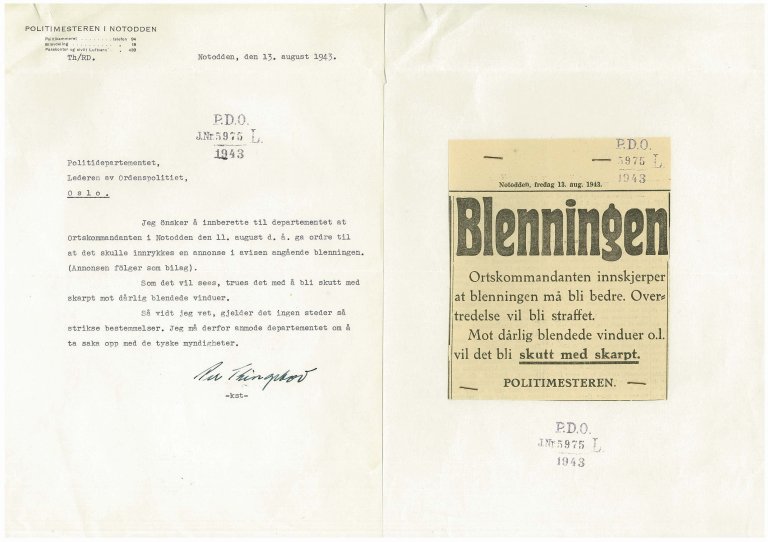
Relevant archives in Arkivportalen
The civil population in Norway was overall less troubled than in many other parts of a Europe that was devastated by war. Still, the years of occupation represented an absence of the basic security and predictability the average Norwegian was used to.
The imminent danger of bombs
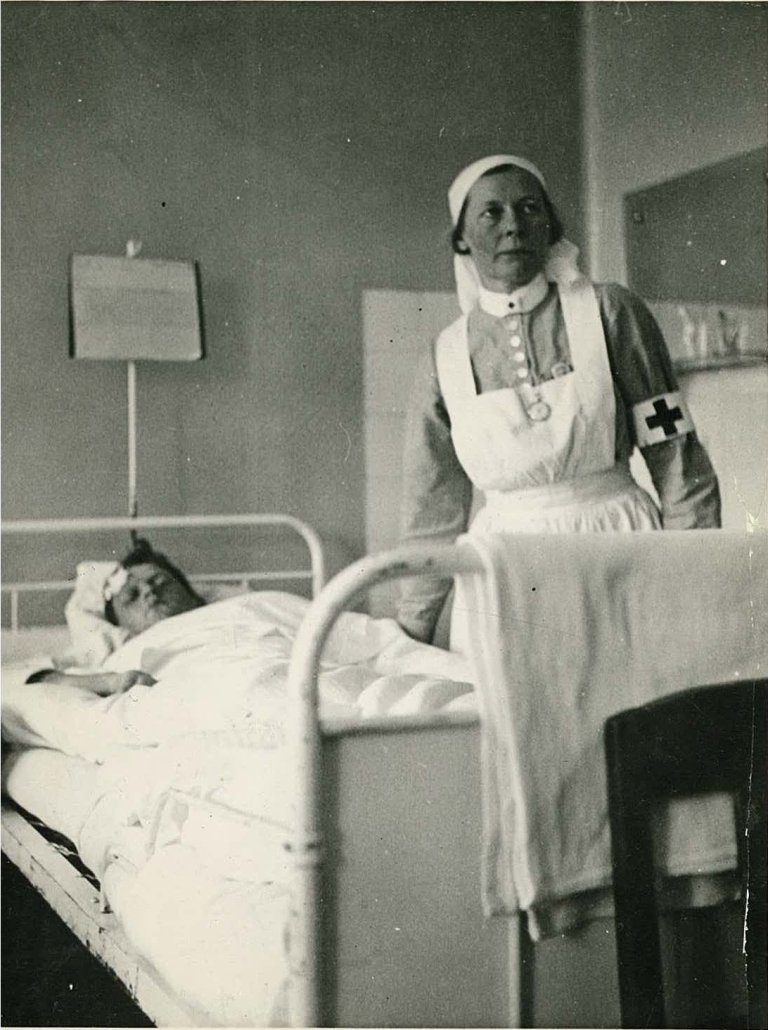
The war’s terror impact on the civil population had many aspects. Air attacks with bombing were particularly frightening. Both the Germans and the allied forces bombed, and the bombing struck civilian targets extensively. The imminent danger of bombing and the worrying and unease of who would be hit next time were in itself a psychological strain that became part of everyday life. What it is really like to live with a real threat of bombing, to be on stand-by every night, with the torch on the bed-side table, ready to run to the nearest bomb shelter in case of an alarm, is difficult to imagine for those who have not experienced it. The horror of the sound of the air-raid warning stuck with those who experienced it long after the war ended.
Matters related to bombing in Norway are found in various archives. In the archive from The Office for Civil Air Defense in the Department of Justice you will find reports of bombing in different parts of the country. In Reichskommisariat there is a folder with newspaper clippings about bomb attacks on Norway in the last war years. In the NS help organization there is a folder with reports of bomb attacks, with lists of death victims in the attack on Oslo on New Year’s Eve 1944. Many children describe experiences of bomb attacks in a series of essays handed in for a contest right after the war. These are preserved in The Norwegian Total Abstainers’ Society’s archive. Photographic documentation of bombed out areas is especially plentiful in NTB’s war archive, but there is photo material in archives of the Armed Forces Military History Department and in the earlier mentioned Office for Civil Air Defense as well.
The presence of an occupation force
Having an occupation force in the country that took liberties, requisitioned apartments, schools and other buildings and spread their detested banners and symbols, created a general feeling of anxiety. Although the German soldiers were ordered to behave properly towards the civilian population in Norway, they had the authority to control and the right to arrest people they thought were suspicious. Continuously new regulations, laws, rules and demands made it possible to get into trouble with the legislative authorities and to be in danger of being arrested for trifles. For those who in some way were involved in illegal work, there was an imminent danger of being arrested, and it was a big strain on the whole family to be living in fear of hammering on the door at night. Regulations where the penalty for radio listening and reading illegal papers was death made matters worse. Sudden actions from the occupation force, like hostage-taking and reprisals as revenge for sabotage activities were not unusual and created a general anxiety not only for those involved, but also for the society surrounding them. The archive of the state police is a rich source of everything that has to do with charges, arrests, investigations, police actions and controls.
Rumours and squealing
Guarding your words and actions in public was also a part of everyday life. Squealing was not unusual, and allusions of illegal activity or a hostile statement against the occupation force on the bus or in the grocery store could be picked up by someone with the opposite opinion, or by someone who had something against you. It could lead to a report, arrest and interrogation and a possible stay in prison or a camp. You will find such cases in the archive of the state police and in the treason archive. In the latter archive you will find the reports that led to informer accusations after the war.
Relevant archives in Arkivportalen
- PA-1209 NTBs krigsarkiv/U/Ud/L0080 and L0081
- RAFA-2174 Reichskommissariat/Ed/63/2 Bomben und terrorangriffe auf Norwegen
- PA-0775 NS FO 2 Stor-Oslo, Hjelpeorganisasjonen/Fa/3/9 The bomb attack, reports, etc.
- S-1329 Statspolitiet
- RAFA-2017 Forsvarets krigshistoriske avdeling/Ec/126/11Photographs of British bomb attacks on Bergen 10.5.1940
When there was a shortage of food in the shops, people had to rethink and use the possibilities they had to get enough food and other necessities.
The cities were worst off
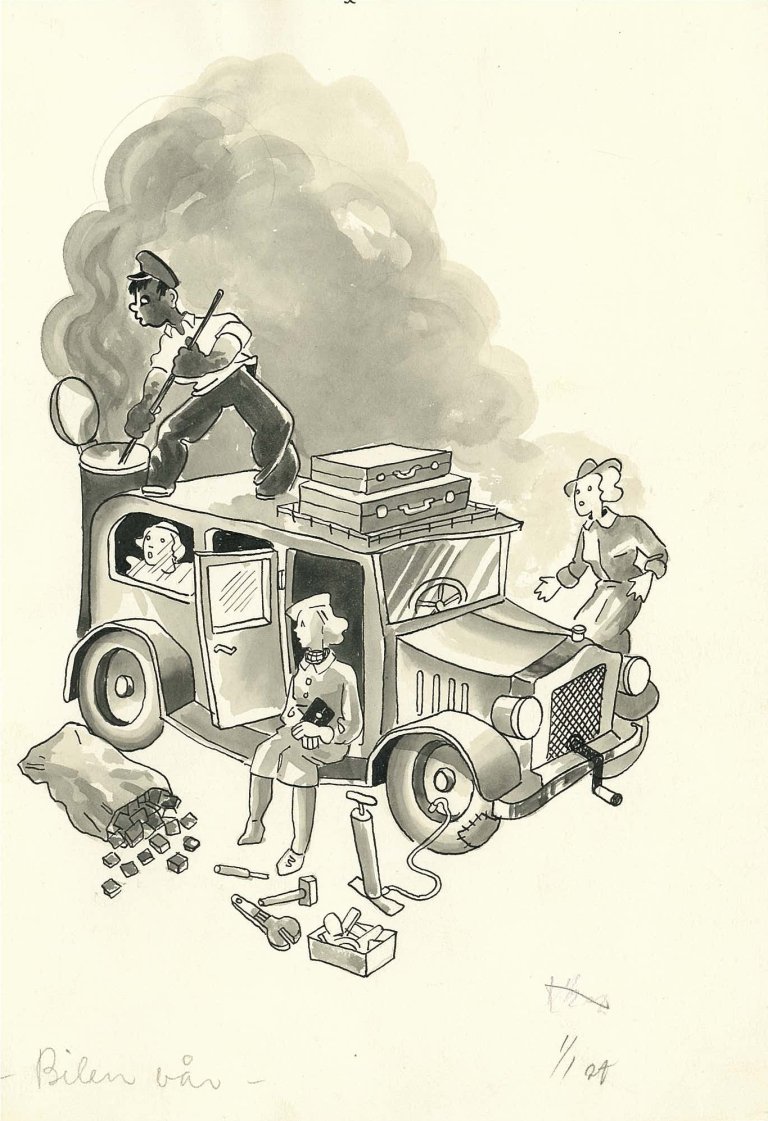
In was particularly critical in the cities when there was nothing to buy in the shops. The growing of potatoes, Swedish turnips and carrots became a usual activity for anyone who had a small garden patch available. The municipalities distributed allotments in parks and outlaying fields, and beautiful rose beds were replaced with useful potato fields. In the NTB war archive you can see several photos with extensive captions that show how people used their imagination and how the shortage made an impact on how people organized themselves.
Food of weed and paper clothes
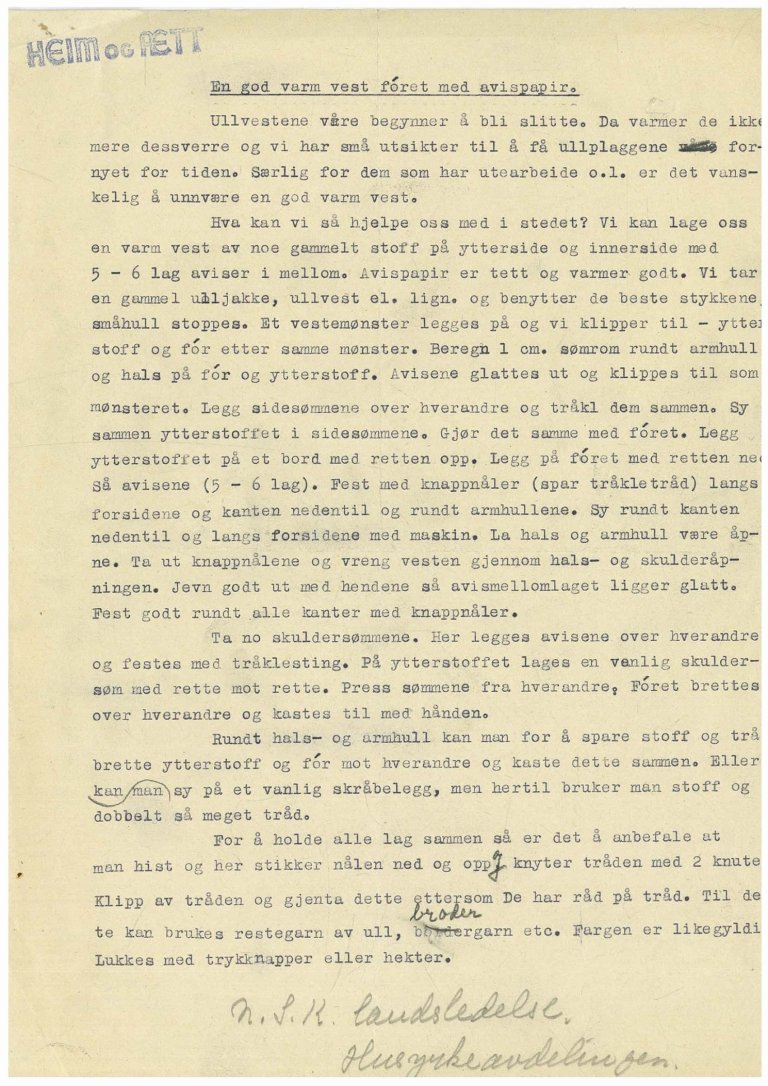
The natural resources were exploited to the fullest. The picking of berries gave important vitamin supplements during the winter months, even though the jam was very sour due to the lack of sugar. In the NS women’s organization’s archive, there are lots of recipes, tips and advice for housewives regarding cooking, sewing and the exploitation of the available resources. This goes especially for the archive series ”Heim og ætt”, the magazine of the women’s organization. The editorial office received tips on the use of wild plants such as goutweed, thistle and wild caraway in dishes and horse chestnut as soap. The use of newspapers for sewing is another example.
Villa pigs
Having rabbits, hens and pigs became usual in the cities even though the space was limited and the access to fodder was poor. In the Reichskommissariat’s archive there are regulations regarding having so-called “villa pigs”. In this archive you can also find recipes for emergency food and assessments of opportunities to increase resource utilization of alternative production methods.
During the war there was a lack of almost everything. All import of goods from the countries Germany was at war with was stopped, and in addition the German occupation force requisitioned food and equipment for their own forces.
Rationing
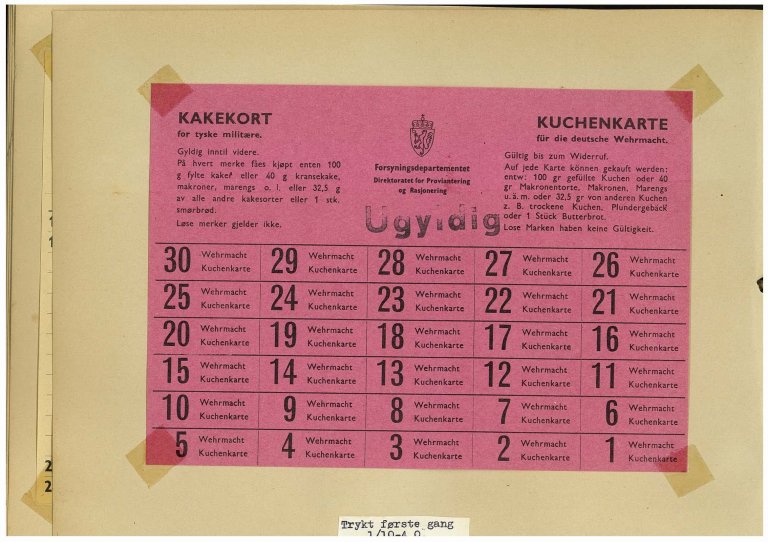
To make sure that the available goods were distributed fairly and to avoid hoarding, the authorities introduced rationing. Sugar, coffee and flour were rationed first, and then followed all imported foodstuffs as well as bread, fat, meat, egg, milk and dairy products. In the summer of 1942, vegetables and potatoes were also rationed. Each household was given one ration book per family member – this was a kind of ticket that gave the right to buy a certain amount of a particular food item. The rations varied from age and gender and were adapted to special needs in for instance infants, pregnant women and people with hard physical work. If you were sick and had a medical certificate stating that you had a medical reason to have a special diet, you could to some extent be given extra rations of certain types of food.
The overall responsibility of the administration and implementation of rationing was under the Department of Supplies. There are extensive archives from this department. It is mainly in 1st Rationing Office/Rationing Office D and 2nd Rationing Office that you find sources for rationing issues. In the former archive you find an overview of all varieties of ration cards. There are large amounts of in- and outgoing correspondence, applications for extra rations and requests of various kinds as well as notices and circulars. In 2nd Rationing Office there is an administrative archive concerning the distribution of rationed goods to various commercial users. The material is mostly organized by industry and alphabetically by names within each industry. The archive also contains correspondence with supplying committees and information about rationing to municipalities, organized by counties.
Unpractical and bothersome
It was very unpractical and required much organizing to operate with rationing cards. You had to bring the cards wherever you wanted to buy anything. In the shop, in a café or restaurant – without cards you didn’t get anything. The quotas were geographically restricted and you couldn’t just bring your rationing cards somewhere else. First you had to get a signature from the local supplying committee. If you went to visit your neighbor, it was normal to bring your ration. In the 2nd Rationing Office’s archive you can find correspondence with the local supplying committee regarding rationing issues.
The lack of goods increased
Eventually the lack of food on the regular market was so great that it couldn’t fill the small rations you had. What was the use of meat rations if there was no meat to buy? When news came of a shop having received shipment of some sought-after food, it lead to lots of people showing up and long lines. A big part of the everyday lives of housewives was therefore characterized by standing in lines, hoping to get the ration they were entitled to. In the war archive of NTB there are many photos illustrating both line-ups and other phenomena related to the shortage of goods and rationing.
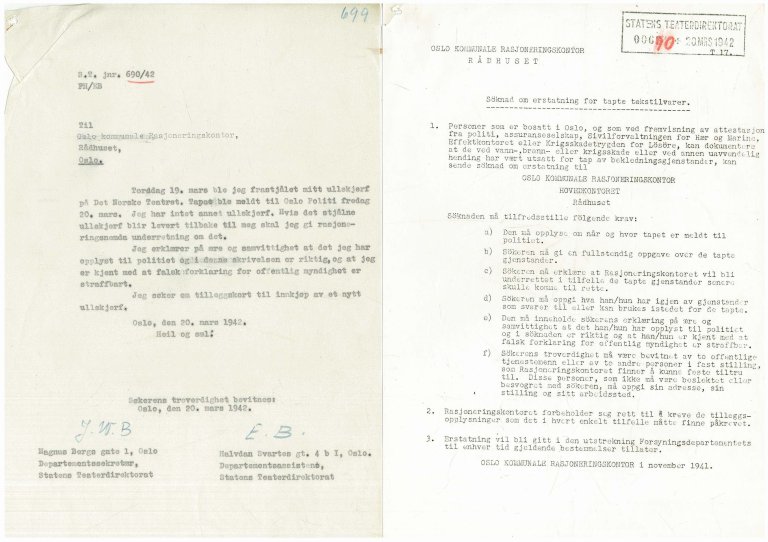
Relevant archives in Arkivportalen
- S-1317 Forsyningsdepartementet, 1. Rasjoneringskontor/Rasjoneringskontoret D
- S-1316 Forsyningsdepartementet, 2. rasjoneringskontor K
- PA-1209 NTBs krigsarkiv/Ue/0099-0101